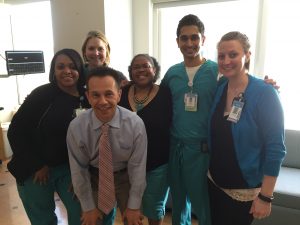In the mid-nineteenth century, Hungarian obstetrician Ignaz Semmelweis was practicing in Vienna, Austria, when he discovered the connection between clean hands of physicians and nurses and patient safety. In this piece, Hospital Epidemiology at UNC Hospitals informs us about Semmelweis – and credits UNC Hospitals obstetricians for carrying on his legacy through participation in Clean In, Clean Out.

It wasn’t too long ago that the concept of washing your hands was not only not part of standard medical practice, but was, in fact, considered odd. A Hungarian physician by the name of Ignaz Semmelweis made the vital connection between hand washing and the reduction of the transmission of disease. Unfortunately, his revolutionary work was initially shunned by scientists and physicians, and it wasn’t until many years later that his discoveries were validated and that hand washing became a well-established practice.
Today, we know that hand hygiene is a key intervention for preventing health care–associated infections; however, maintaining high compliance is a challenge, and accurate measurement of compliance can be difficult. At UNC Hospitals, the implementation of our novel program, Clean In, Clean Out, has engaged all health care personnel to measure compliance and provide real-time interventions. To date, more than 330,000 observations have been made by personnel from all job classes (physicians, nurses, and members of housekeeping, radiology, phlebotomy, respiratory therapy, nutrition and food services, and occupational and physical therapy departments), with compliance rates in the inpatient, outpatient and OR setting remaining above 90%. In year three of Clean In, Clean Out, since increased physician participation became one of the goals, our obstetricians/gynecologists have led the way in physician participation, contributing over 75% of all observations submitted by physicians/advanced practice providers. This is an interesting coincidence, since Semmelweis, now considered the pioneer of antisepsis, was a practicing obstetrician when he made his important discovery about the critical importance of hand washing.
In 1846, Semmelweis was working in an obstetrical clinic in Vienna General Hospital. He began studying puerperal fever, also known as ‘childbed fever,’ a common cause of mortality in the mid-nineteenth century, in two maternity wards. One ward had an average maternal mortality rate of 18%, while a neighboring second ward had a less than 4% maternal mortality rate. The public was aware of these staggering differences in mortality rates. The wards would admit on alternate days, but women begged to be admitted to the second ward, due to the bad reputation of the first ward. Some women even preferred to give birth in the streets rather than be admitted to the first ward. Semmelweis was puzzled as to why the incidence of puerperal fever differed among the wards and was so rare among the women having street births.
In an attempt to unearth any differences that may explain the disparity in mortality rates, Semmelweis did a comprehensive comparison of the two wards. The only major difference was the individuals who worked there – medical students who were being taught to perform autopsies versus midwives who were being taught how to support mothers during pregnancy and birth. He was still perplexed about the different mortality rates, when a good friend of his died after being poked with a student’s scalpel. Lab tests revealed that the pathology found during autopsy was the same as pathology from the women dying from puerperal fever. Semmelweis made a groundbreaking connection and concluded that he and the medical students carried ‘cadaverous particles’ on their hands from the autopsy room to the patients they examined. He realized that the mortality rate was much lower in the ward staffed by midwives (and in the streets!) since they did not perform autopsies. He instituted hand washing with a chlorinated lime solution between autopsy work and the examination of patients. The maternal mortality rate decreased to 1.9%!
Despite these impressive results, the scientific and medical community summarily rejected his findings. Many physicians were offended at the suggestion that they should wash their hands and outraged that they were being implicated as a cause of death. Semmelweis was dismissed from the hospital and subjected to harassment by the medical community. This resistance and criticism incensed Semmelweis and he responded by writing angry letters to prominent obstetricians, at times going as far as to call them irresponsible murderers. As his behavior became more and more erratic, his peers, and even his own wife, felt that he was losing his mind. In 1865, he was committed to an asylum, where he died 14 days later — ironically, of septicemia. Sadly, it was not until years later when Louis Pasteur discovered that germs cause infectious diseases that Semmelweis’s observations and the man himself were given the recognition that they deserved.
Today, at UNC Hospitals, thanks to the overwhelming success of Clean In, Clean Out, the practice of hand washing has become interwoven into the culture of patient safety. Data from the first year of the program demonstrate that more unique observers per job class leads to higher compliance rates and that higher hand hygiene compliance rates have led to decreased infection rates. One of our FY16 goals has been to increase participation among physicians/advanced practice providers to >50 unique physicians/APP per month. Currently, fewer than 15 physicians, mostly obstetricians/gynecologists, are submitting observations per month. We need more hands on deck to maintain our hand washing success! It only takes a few minutes to submit a hand hygiene observation. Visit http://news.unchealthcare.org/empnews/handhygiene for more information on Clean In, Clean Out program and to learn how to submit observations. Thanks to the innovative work done by Semmelweis, we know that clean hands save lives!
By Lauren DiBiase, Public Health Epidemiologist, UNC Hospitals Epidemiology